
When planning your next knitting project, it’s essential to choose the right yarn as it can be tricky. The fiber you pick changes how your knitwear looks and feels. Wool is warm and stretchy, while cotton is light and airy. Each fiber adds its own style to your project. Knowing these differences helps you choose the right yarn that fits your plan. Whether making a warm sweater or a cool summer top, your yarn choice matters. Want to learn why choosing the right yarn is important? Let’s get started!
Key Takeaways
Choosing the right yarn affects the look and feel of your knitwear. Consider the fiber type, like wool for warmth or cotton for breathability.
Understand yarn weights to match your project. Use worsted or DK weight for sweaters and fingering weight for lightweight summer tops.
Texture matters! Smooth yarns highlight stitches, while textured yarns add depth. Pick based on the style you want for your knitwear.
Check yarn durability and care instructions. Strong yarns like wool or blends last longer and are easier to maintain.
Explore eco-friendly options. Organic cotton and recycled yarns are great for the planet and your projects.
Types of Yarn and Their Characteristics
Exploring yarn can feel confusing because there are so many types. Each yarn has special traits that affect your knitting project. Let’s look at the main yarn types and what makes them unique.
Natural Fibers: Wool, Cotton, and More
Natural fibers are loved for being soft, breathable, and eco-friendly. Wool is very popular. It’s warm, stretchy, and great for sweaters or scarves. Wool also keeps its shape well because it’s elastic. Cashmere is even softer and feels amazing on your skin. It’s perfect for fancy clothing.
Cotton is light and airy. It’s ideal for summer clothes or neat designs. Cotton doesn’t stretch much, so it works best for structured pieces. Other fibers like alpaca and silk have their own perks. Alpaca is warm and soft, while silk adds shine and elegance to your work.
Natural fibers are better for the planet than synthetic ones. They break down naturally and use fewer chemicals to make. If you want eco-friendly knitwear, natural fibers are a smart choice.
Synthetic Fibers: Acrylic, Nylon, and Polyester
Synthetic yarns are made from materials like acrylic, nylon, and polyester. These yarns cost less than natural ones, making them good for big projects. Acrylic yarn is soft, light, and easy to clean. Beginners like it because it’s cheap and comes in many colors.
Nylon and polyester yarns are tough and last a long time. They’re great for bags or outdoor items. But synthetic yarns don’t breathe well, so they’re not the best for clothes worn close to your skin.
One problem with synthetic yarns is they harm the environment. They don’t break down and can cause microplastic pollution. If you care about the planet, try mixing synthetic yarns with natural ones to lessen the impact.
Blended Yarns: Combining Strengths of Different Fibers
Blended yarns mix two or more fiber types. This gives you yarn with the best features of each fiber. For example, wool-acrylic blends are warm and soft like wool but cheaper and tougher like acrylic.
Cashmere blends are popular too. Mixing cashmere with wool or silk makes soft, fancy yarn that costs less than pure cashmere. Cotton-polyester blends are light, breathable, and strong, perfect for summer clothes.
Blended yarns also offer different textures and looks. Some blends are smooth, fuzzy, or shiny, depending on the fibers. Picking the right blend lets you make knitwear that’s useful and stylish.
Tip: Look at the label when buying blended yarns. It shows the fiber percentages, helping you know how the yarn will act in your project.
How to Choose the Right Yarn Weight
Understanding Yarn Weight Categories
Yarn weights can feel like a mystery at first, but they’re actually pretty simple once you know the basics. Yarn weight refers to how thick or thin the yarn is, and it plays a big role in how your knitwear turns out. There are several categories, ranging from lace weight (super thin) to jumbo weight (extra thick).
Here’s a quick breakdown:
Lace Weight: Perfect for delicate shawls or lightweight scarves.
Fingering Weight: Great for socks and fine garments.
DK (Double Knit) Weight: A versatile choice for sweaters and accessories.
Worsted Weight: Popular for cozy sweaters and blankets.
Bulky and Jumbo Weights: Ideal for chunky scarves or quick projects.
Each category has its own charm. Knowing these weights helps you choose the right yarn for your project with confidence.
Matching Yarn Weight to Your Project
Picking the right yarn weight depends on what you’re making. If you’re knitting a sweater, worsted or DK weight yarns are solid choices. They’re warm and have just the right thickness for everyday wear. For lightweight summer tops, fingering or sport weight yarns work best.
Accessories like hats or mittens often call for bulky yarns. They knit up fast and keep you warm. Lace weight yarns are perfect for elegant shawls or wraps. Always check your pattern to see which yarn weight it recommends.
Tip: Swatch before you start! Knitting a small sample lets you see how the yarn weight behaves with your chosen stitch pattern.
How Weight Affects Drape and Warmth
Yarn weight doesn’t just affect the look of your knitwear—it changes how it feels and moves. Lighter yarn weights, like lace or fingering, create soft, flowing fabrics. These are great for garments that need a lot of drape, like shawls or summer tops.
Heavier yarn weights, like bulky or jumbo, make thicker, stiffer fabrics. These are perfect for cozy blankets or chunky sweaters. Worsted weight yarns strike a balance, offering both warmth and flexibility.
Warmth also depends on yarn weight. Thicker yarns trap more heat, making them ideal for winter wear. Lighter yarns are breathable and better for warmer weather. Choosing the right yarn weight ensures your knitwear feels just right for its purpose.
Texture and Stitch Definition in Knitting
When you’re choosing yarn for your knitwear, texture plays a huge role in how your finished piece will look and feel. The texture of the yarn can highlight your stitches or create a soft, blended effect. Let’s dive into how texture impacts your knitting projects.
Smooth vs. Textured Yarns
Smooth yarns are great when you want your stitches to stand out. They create clean, crisp lines, making them perfect for intricate patterns like cables or lace. If you’re working on a detailed sweater or scarf, smooth yarn will let your hard work shine.
Textured yarns, on the other hand, add depth and character to your knitwear. These yarns can be fuzzy, nubby, or even boucle. They’re ideal for simple patterns where the texture itself becomes the star. A textured yarn can make a plain stockinette stitch look rich and interesting.
Tip: If you’re unsure, try knitting a small swatch with both smooth and textured yarns. You’ll see how each one affects the look of your stitches.
Choosing Texture Based on Knitwear Style
The style of your knitwear often determines the best yarn texture to use. For classic, tailored pieces like cardigans or pullovers, smooth yarns work best. They give a polished, professional finish.
For cozy, casual items like chunky sweaters or blankets, textured yarns add warmth and charm. Imagine a soft, fuzzy yarn for a winter hat—it’s both functional and stylish. Always think about the vibe you want your knitwear to have when picking the texture.
Enhancing Patterns with the Right Yarn Texture
The right yarn texture can take your patterns to the next level. Smooth yarns enhance stitch definition, making complex designs pop. This is especially important for projects with cables, lace, or colorwork.
Textured yarns, however, can soften bold patterns or add a unique twist to simple designs. They’re perfect for creating a one-of-a-kind look. If you’re experimenting with new patterns, don’t be afraid to play around with different yarn textures.
Note: Keep in mind that textured yarns can sometimes hide intricate stitches. If your pattern relies on fine details, smooth yarn might be the better choice.
Durability and Care Requirements
When picking yarn, think about how long it lasts and how to care for it. You want your knitwear to stay nice without too much work. Let’s make it simple to choose wisely.
Picking Strong Yarns for Daily Use
For clothes you’ll wear a lot, like sweaters or scarves, choose strong yarns. Wool is a good pick because it’s tough and stretchy. It keeps its shape even after many uses. Blended yarns, like wool mixed with acrylic, are also great. They mix the strength of synthetic fibers with the softness of natural ones.
For items like bags or gloves that get used a lot, try nylon or polyester yarns. These are strong and last a long time. But they don’t breathe as well as natural fibers. If you want both strength and comfort, pick yarns that combine natural and synthetic fibers.
Tip: Look at the yarn label for clues about strength. Words like “high-twist” or “reinforced” mean the yarn will last longer.
Easy vs. Delicate Care
How you clean your knitwear depends on the yarn. Some yarns, like superwash wool or acrylic, can go in the washing machine. These are great for everyday items because they’re easy to clean.
Delicate yarns, like cashmere or untreated wool, need hand washing. They feel fancy but need extra care to avoid damage. If you’re busy, pick yarns with simple cleaning instructions.
Note: Always read the care label before buying yarn. It helps you avoid surprises later!
Mixing Practicality with Style
Strong and easy-care yarns don’t have to look boring. Wool and cotton are both pretty and useful. They’re soft, breathable, and come in many styles. For a fancy touch, try cashmere blends. They’re soft like cashmere but easier to care for.
If you’re saving money, synthetic yarns can look like natural ones. They’re also easier to clean, which is great for beginners. The best yarn is one that fits your needs and looks good.
Remember: The right yarn balances strength, care, and style.
Matching Yarn to Specific Knitwear Projects

Choosing the right yarn for your knitwear project can make all the difference. Whether you’re crafting a cozy sweater, stylish accessories, or lightweight summer garments, the yarn you pick will shape the look, feel, and durability of your creation. Let’s explore how to match yarn to different types of knitwear.
Yarns for Sweaters and Cardigans
Sweaters and cardigans need yarn that’s warm, durable, and comfortable. Wool is a top choice for these projects. It’s naturally insulating, stretchy, and holds its shape well. For extra softness, you can try cashmere or wool blends. These fibers feel luxurious and add a touch of elegance to your knitwear.
If you’re looking for something lighter, cotton is a great option. It’s breathable and works well for sweaters you’ll wear in warmer weather. Cotton blends, like cotton-acrylic, combine the softness of natural fibers with the durability of synthetic ones.
For chunky sweaters, bulky-weight yarns are ideal. They knit up quickly and create thick, cozy fabrics. Worsted-weight yarns are versatile and work for most sweater patterns. Always check your pattern to see which yarn weight is recommended.
Tip: If you want your sweater to last, choose yarns with high-twist fibers. They’re less likely to pill and will keep your knitwear looking fresh.
Yarns for Accessories: Hats, Scarves, and Mittens
Accessories like hats, scarves, and mittens let you experiment with different yarns. Wool is a classic choice for winter accessories because it’s warm and moisture-wicking. For extra durability, try wool-acrylic blends. These yarns are tough enough to handle daily wear while staying soft and cozy.
For scarves, textured yarns like boucle or alpaca add visual interest and a luxurious feel. If you’re knitting a hat, bulky-weight yarns are perfect for creating a snug fit and quick results. Mittens need yarn that’s both warm and durable, so wool or wool-blend yarns are your best bet.
If you’re making accessories for warmer weather, cotton or bamboo yarns are lightweight and breathable. They’re great for creating stylish pieces that won’t feel too heavy.
Note: When knitting accessories, consider the care requirements of your yarn. Machine-washable options are ideal for items that will see frequent use.
Yarns for Lightweight and Summer Knitwear
Summer knitwear calls for yarns that are light, breathable, and comfortable against the skin. Cotton is the go-to fiber for warm-weather projects. It’s natural, airy, and perfect for creating tops, dresses, or lightweight cardigans.
For a touch of elegance, silk or silk-blend yarns add a beautiful sheen and drape to your garments. Bamboo yarns are another excellent choice. They’re soft, eco-friendly, and have a cooling effect, making them ideal for summer wear.
Fingering or sport-weight yarns work best for lightweight knitwear. They create fabrics that flow beautifully and won’t feel bulky. If you’re looking for sustainable options, explore organic cotton or recycled fibers. These yarns are kinder to the planet and still deliver great results.
Tip: Swatch your yarn before starting your project. This helps you see how the fabric will drape and ensures it’s the right fit for your summer knitwear.
Budget and Sustainability in Yarn Selection
Balancing Cost and Quality
Finding yarn that’s affordable and good quality isn’t hard. You don’t need pricey yarn to make nice knitwear. Cheaper yarns like acrylic or cotton blends work well. They last long and come in many colors, great for daily projects.
For special items, spending more on wool or cashmere is smart. Wool is warm and stretchy, while cashmere is soft and fancy. Blended yarns, like wool mixed with acrylic, give you both quality and a lower price.
Tip: Read the yarn label for care and durability info. It helps avoid problems later.
Exploring Eco-Friendly Yarn Options
If you care about the planet, eco-friendly yarns are a great pick. Organic cotton is grown without bad chemicals, so it’s safer for nature and your skin. Recycled yarns, like reused wool or polyester, help cut waste while looking nice.
Bamboo yarn is another green choice. It’s soft, airy, and shiny. For something fancy, try silk blends made from eco-friendly materials. These yarns feel amazing and help the Earth.
Note: Look for labels like GOTS (Global Organic Textile Standard). They show the yarn is truly eco-friendly.
Supporting Local and Independent Yarn Producers
Buying yarn from small businesses helps them and gives you unique finds. Many small makers sell hand-dyed or special yarns that stand out. These often use natural fibers, making them pretty and eco-friendly.
Shopping local also lowers the travel impact of your yarn. Instead of big factory-made yarn, you get something made with care. Plus, you can meet the makers and learn their stories.
Tip: Check out local yarn shops or craft fairs. You might find a special yarn for your next project.
Picking the right yarn might seem hard at first. Start by learning the basics. Wool is warm, cotton is light, and blends mix features. Choose yarn that fits your project, like sweaters or summer tops. Check how to clean it and if it lasts long. Try out different yarns to see what you like best. With time, you’ll find the perfect yarn to make your projects amazing!
FAQ
What yarn works best for sweaters?
Wool is great for warm, stretchy sweaters. It’s durable too. For softer sweaters, try cashmere or wool blends. Worsted-weight yarns fit most sweater patterns. For lighter sweaters, cotton blends are perfect for warmer days.
How are cotton and wool different for knitwear?
Cotton is light and airy, great for summer clothes. Wool is warm and cozy, perfect for winter wear. Cotton doesn’t stretch much, but wool is flexible and keeps its shape. Use cotton for firm designs and wool for comfy, stretchy pieces.
Are blended yarns better than single-fiber ones?
Blended yarns mix the best parts of fibers. Wool-acrylic blends are warm and strong. Cotton-polyester blends are breathable and tough. They’re often cheaper and more useful than single-fiber yarns. Check the label to see what’s inside.
What’s the most eco-friendly yarn for clothes?
Organic cotton and bamboo yarns are kind to the planet. Recycled fibers, like reused wool or polyester, cut down waste. Look for GOTS labels to ensure they’re eco-friendly. Buying local yarn also helps the Earth and supports small businesses.
How can I find soft yarn for sweaters?
Cashmere and alpaca are super soft and fancy. Merino wool blends are soft and last longer. Acrylic yarn feels like natural fibers but costs less. Always touch the yarn to see if it’s soft enough for you.



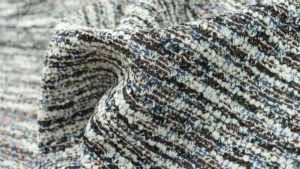
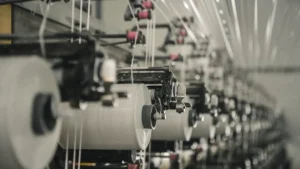
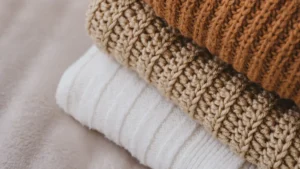

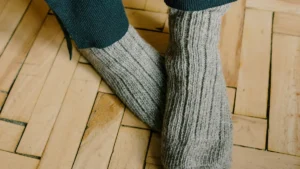
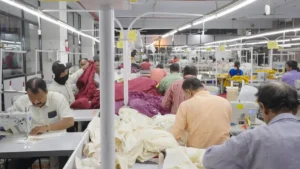

13 thoughts on “How to Choose the Right Yarn for Your Knitwear Collection”
Pingback: Mastering Knitting: From Chunky Knit Blankets to Baby Knit Clothes including Needles, Cast-On Methods & Beyond
Pingback: Modern Knitting Culture: From Live Music Venues to Scandinavian Yarn Brands and Winter Accessories
Pingback: The Ultimate Guide to Knit Cardigans, Polos, and Patterned Jumpers
Pingback: Engineering Style in Stitches: How a Professional Factory Creates the Ultimate Knitted Dress and Knit Maxi Dress
Pingback: 10 Best Wholesale Knitted Bag Suppliers for Boutiques in 2025
Pingback: Best Knit Apparel Makers in Houston You Should Know
Pingback: 10 Best Knitting Manufacturers in London for Small Businesses
Pingback: 10 Top Supplier Choices for Knit Garments in Amsterdam
Pingback: Top 9 Custom Knitwear Producers in Rotterdam for 2025
Pingback: Pinstripe Knitwear for Women—Jackets, Skirts & Sets
Pingback: Luxury Fibers: A Comprehensive Guide to Luxury, Eco-Friendly & Budget Fibers for B2B Knitwear Sourcing
Pingback: Choosing the Right Fiber: Mohair vs. Cashmere, Alpaca, and Other Luxury Yarns for Knitwear Sourcing
Pingback: Understanding Mohair Yarn and Its Appeal for Crafters